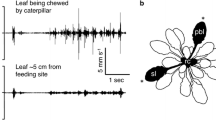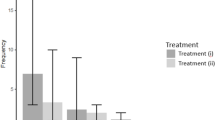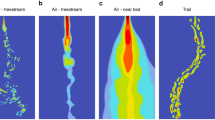Summary
-
1.
The escape behavior of the cockroach, Periplaneta americana, is known to be modulated under various behavioral conditions (Camhi and Volman 1978; Camhi and Nolen 1981; Camhi 1988). Some of these modulatory effects occur in the last abdominal ganglion (Daley and Delcomyn 1981a, b; Libersat et al. 1989) and others in the thoracic ganglia (Camhi 1988). Neuromodulator substances are known to underlie behavioral modulation in various animals. Therefore, we have sought to determine whether topical application of putative neuromodulators of the escape circuit enhance or depress this circuit, and whether these effects differ in the last abdominal vs. the thoracic ganglia.
-
2.
Topical application of the biogenic amines serotonin and dopamine to the metathoracic ganglion modulates the escape circuitry within this ganglion; serotonin decreases and dopamine enhances the response of leg motoneurons to activation of interneurons in the abdominal nerve cord by electrical or wind stimulation (Figs. 2–7).
-
3.
The neuropil of the thoracic ganglia contains many catecholamine-histofluorescent processes bearing varicosities, providing a possible anatomical substrate for dopamine release sites (Fig. 8).
-
4.
Topical application of octopamine to the terminal abdominal ganglion enhances the response of abdominal interneurons to wind stimulation of the cerci (Figs. 10, 11). In contrast, serotonin and dopamine have no effect at this site (Figs. 9, 11).
-
5.
It is proposed that release of these biogenic amines may contribute to the known modulation of the cockroach escape response.
Similar content being viewed by others
Abbreviations
- GI :
-
abdominal giant interneuron
- TI :
-
thoracic giant interneuron
- 5-HT :
-
5-hydroxytryptamine(serotonin)
- CNS :
-
central nervous system
References
Bernard J, Gobin B, Callee JJ (1983) A chordotonal organ inhibits giant interneurons in the sixth abdominal ganglion of the cockroach. J Comp Physiol 153:377–383
Bishop CA, O'Shea M (1983) Serotonin reactive neurons in the central nervous system of an insect (Periplaneta americana). J Neurobiol 14:151–169
Callee JJ, Satelle DB (1973) A simple technique for monitoring the synaptic action of pharmacological agents. J Exp Biol 59:711–723
Camhi JM (1988) Sites of multiple controls of excitability in the escape circuit of the cockroach Periplaneta americana. Soc Neurosci Abst 14:310
Camhi JM, Levy A (1989) The code for stimulus direction in a cell assembly in the cockroach. J Comp Physiol A 165:83–97
Camhi JM, Nolen TG (1981) Properties of the escape system of cockroaches during walking. J Comp Physiol 142:339–346
Camhi JM, Tom W (1978) The escape behavior of the cockroach Periplaneta americana. I. The turning response to wind puffs. J Comp Physiol 128:193–210
Camhi JM, Volman S (1978) Modulation of the threshold in the escape behavior of the cockroach Periplaneta americana. Soc Neurosci Abstr 4:189
Camhi JM, Tom W, Volman S (1978) The escape behavior of the cockroach Periplaneta americana. II. Detection of natural predators by air displacement. J Comp Physiol 128:203–212
Claassen DE, Kammer AE (1986) Effects of octopamine, dopamine, and serotonin on production of flight motor output by thoracic ganglia of Manduca sexta. J Neurobiol 17:1–14
Comer CM (1985) Analyzing cockroach escape behavior with lesions of individual giant interneurons. Brain Res 335:342–346
Daley DL, Delcomyn F (1981a) Modulation of the excitability of cockroach giant interneurons during walking. I. Simultaneous excitation and inhibition. J Comp Physiol 138:213–219
Daley DL, Delcomyn F (1981b) Modulation of the excitability of cockroach giant interneurons during walking. II. Central and peripheral components. J Comp Physiol 138:241–251
Dowd JP, Comer C (1988) The neuronal basis of orienting behavior: A computational approach to the escape turn of the cockroach. Biol Cybern 60:37–48
Evans PD (1980) Biogenic amines in the insect nervous system. Adv Insect Physiol 15:317–473
Evans PD (1985) Octopamine. In: Kerkut GA, Gilbert L (eds) Comprehensive insect biochemistry, physiology and pharmacology. Pergamon Press, Oxford: pp 499–530
Fleming JR, Pitman RM (1983) Histochemical localization of biogenic amines in cockroach neurons. J Physiol (London) 334:98P
Furness JB, Costa M, Blessing (1977) Simultaneous fixation and production of catecholamine fluorescence in central nervous tissue by perfusion with aldehydes. Histochemical J 9:745–750
Glanzman DL, Krasne FB (1983) Serotonin and octopamine have opposite effects on the crayfish's lateral giant escape reaction. J Neurosci 3:2263–2269
Glanzman DL, Krasne FB (1986) 5,7-dihydroxytryptamine lesions of crayfish serotonin-containing neurons: effect on the lateral giant escape reaction. J Neurosci 6:1560–1569
Glover JC, Kramer AP (1982) Serotonin analog selectively ablates identified neurons in the leech embryo. Science 216:317–319
Goldstein RS, Camhi J (1988a) Modulation of activity in windsensitive sensory and interneurons by cereal displacement in the cockroach. J Comp Physiol A 163:479–487
Goldstein RS, Camhi JM (1988b) Effects of endogenous neuromodulators on the thoracic circuitry of the cockroach escape response. Eur Neurosci Soc Abstr 11:76
Goldstein RS, Camhi JM (1988c) Modulation of two portions of the cockroach escape circuit by biogenic amines. Soc Neurosci Abstr 14:383
Kinnamon SC, Klaassen LW, Kammer AE, Ciaassen D (1984) Octopamine and chlordimeform enhance sensory responsiveness and production of the flight motor pattern in developing and adult moths. J Neurobiol 15:283–293
Kupferman I (1979) Modulatory actions of neuromodulators. Ann Rev Neurosci 2:447–465
Lane NJ, Treherne JH (1972) Studies on perineural junctional complexes and the sites of uptake of microperoxidase and lanthanum in the cockroach central nervous system. Tissue Cell 4:427–436
Libersat F, Goldstein RS, Camhi JM (1987) Nonsynaptic regulation of sensory activity during movement in cockroaches. Proc Natl Acad Sci USA 84:8150–8154
Libersat F, Levy A, Camhi JM (1989) Multiple feedback loops in the flying cockroach: Excitation of the dorsal and inhibition of the ventral giant interneurons. J Comp Physiol A 165:651668
Livingstone MS, Harris-Warrick RM, Kravitz EA (1980) Serotonin and octopamine produce opposite postures in lobsters. Science 208:76–79
Mackey S, Carew JT (1983) Locomotion in Aplysia: triggering by serotonin and modulation by bag cell extract. J Neurosci 3:1469–1477
Pasztor VM, Bush BMH (1989) Primary afferent responses of a crustacean mechanoreceptor are modulated by proctolin, octopamine and serotonin. J Neurobiol 20:234–254
Ritzmann RE, Pollack AJ (1988) Wind-activated thoracic interneurons of the cockroach: II. Patterns of connection from ventral giant interneurons. J Neurobiol 19:589–611
Selverston AI (1989) Switching among functional states by means of neuromodulators in the lobster stomatogastric ganglion. Experientia 44:376–382
Sombati S, Hoyle G (1984) Generation of specific behaviors in a locust by local release into neuropil of the natural neuromodulator octopamine. J Neurobiol 15:481–506
Spira ME, Parnas I, Bergmann F (1971) Histological and electrophysiological studies on the giant axons of the cockroach Periplaneta americana. J Exp Biol 50:629–634
Stevenson PA, Kutsch W (1988) Demonstration of functional connectivity of the flight motor system in all stages of the locust. J Comp Physiol A 162:247–259
Watson AHD, Burrows M (1985) The distribution of synapses on two fields of neurites of spiking local interneurons in the locust. J Comp Neurol 240:219–232
Westin J, Langberg JJ, Camhi JM (1977) Responses of giant interneurons of the cockroach Periplaneta americana to wind puffs of different directions and velocities. J Comp Physiol 121:307–324
Author information
Authors and Affiliations
Rights and permissions
About this article
Cite this article
Goldstein, R.S., Camhi, J.M. Different effects of the biogenic amines dopamine, serotonin and octopamine on the thoracic and abdominal portions of the escape circuit in the cockroach. J Comp Physiol A 168, 103–112 (1991). https://doi.org/10.1007/BF00217108
Accepted:
Issue Date:
DOI: https://doi.org/10.1007/BF00217108




